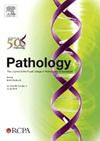HER2-low across solid tumours: different incidences and definitions
IF 3
3区 医学
Q1 PATHOLOGY
引用次数: 0
Abstract
Antibody-drug conjugates, particularly trastuzumab deruxtecan (T-DXd), have emerged as effective therapies for various solid tumours. Clinical trials show that T-DXd improves survival in both HER2-positive and HER2-low breast cancer patients. Additionally, it improves survival in HER2-positive gastro-oesophageal cancer and elicits objective responses in HER2-low tumours. Responses have also been noted in lung and gynaecological cancers with HER2 expression, although subgroup analyses for HER2-low cases are lacking. This review assesses HER2 protein expression levels and gene amplification across solid tumours where T-DXd shows potential benefits. We focus on the accuracy and limitations of HER2 testing methods, particularly for identifying HER2-low cancer. A semi-systematic approach was employed, searching EMBASE, Medline, Cochrane, and PubMed databases. We calculated median incidences of HER2-positive, HER2-low, and HER2-0 by immunohistochemistry (IHC), and HER2 amplification by in situ hybridisation (ISH). A total of 144 studies were included, covering breast (n=57), gastro-oesophageal (n=33), lung (n=17), gynaecological (n=24), and various other carcinomas (n=13). The median incidences of HER2-low were 52%, 16%, 58%, and 17% in breast, gastro-oesophageal, endometrial, and ovarian cancers, respectively, with unknown incidences in lung and cervical cancers. Factors influencing HER2-low detection include tumour heterogeneity, antibody clones, observer variability, and lack of validated scoring criteria. Given the significant proportion of HER2-low cases, many patients could benefit from T-DXd, but limitations in detection accuracy necessitate further research and standardisation in diagnostic methods and criteria to advance the clinical utility of T-DXd for HER2-low tumours.
实体肿瘤中her2低:不同的发生率和定义
抗体-药物缀合物,特别是曲妥珠单抗德鲁西替康(T-DXd),已经成为各种实体肿瘤的有效治疗方法。临床试验表明,T-DXd可提高her2阳性和her2低水平乳腺癌患者的生存率。此外,它可以提高her2阳性胃食管癌患者的生存率,并在her2低的肿瘤中引起客观反应。在HER2表达的肺癌和妇科癌症中也发现了应答,尽管缺乏HER2低病例的亚组分析。本综述评估了在T-DXd显示潜在益处的实体肿瘤中HER2蛋白表达水平和基因扩增。我们关注HER2检测方法的准确性和局限性,特别是在识别HER2低水平癌症方面。采用半系统方法,检索EMBASE、Medline、Cochrane和PubMed数据库。我们通过免疫组织化学(IHC)和原位杂交(ISH)计算了HER2阳性、HER2低和HER2-0的中位发生率。共纳入144项研究,包括乳腺癌(n=57)、胃食管癌(n=33)、肺癌(n=17)、妇科(n=24)和各种其他癌症(n=13)。her2低的中位发生率在乳腺癌、胃食管癌、子宫内膜癌和卵巢癌中分别为52%、16%、58%和17%,在肺癌和宫颈癌中的发生率未知。影响her2低检测的因素包括肿瘤异质性、抗体克隆、观察者可变性和缺乏有效的评分标准。鉴于her2低病例的显著比例,许多患者可以从T-DXd中受益,但检测准确性的限制需要进一步研究和标准化诊断方法和标准,以推进T-DXd在her2低肿瘤中的临床应用。
本文章由计算机程序翻译,如有差异,请以英文原文为准。
求助全文
约1分钟内获得全文
求助全文
来源期刊

Pathology
医学-病理学
CiteScore
6.50
自引率
2.20%
发文量
459
审稿时长
54 days
期刊介绍:
Published by Elsevier from 2016
Pathology is the official journal of the Royal College of Pathologists of Australasia (RCPA). It is committed to publishing peer-reviewed, original articles related to the science of pathology in its broadest sense, including anatomical pathology, chemical pathology and biochemistry, cytopathology, experimental pathology, forensic pathology and morbid anatomy, genetics, haematology, immunology and immunopathology, microbiology and molecular pathology.
 求助内容:
求助内容: 应助结果提醒方式:
应助结果提醒方式:


